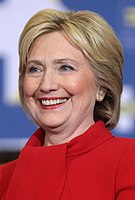| ||||||||||||||||||||||||||
| Turnout | 65.3% | |||||||||||||||||||||||||
|---|---|---|---|---|---|---|---|---|---|---|---|---|---|---|---|---|---|---|---|---|---|---|---|---|---|---|
| ||||||||||||||||||||||||||
Clinton 70–80% 80–90% 90-100%
| ||||||||||||||||||||||||||
| ||||||||||||||||||||||||||
| Elections in the District of Columbia |
|---|
 |
The 2016 United States presidential election in the District of Columbia was held on Tuesday, November 8, 2016, as part of the 2016 United States presidential election in which all fifty states and the District of Columbia participated. District of Columbia voters chose electors to represent them in the Electoral College via a popular vote, pitting the Republican Party's nominee, businessman Donald Trump, and running mate Indiana Governor Mike Pence against Democratic Party nominee, former Secretary of State Hillary Clinton, and her running mate Virginia Senator Tim Kaine. The District of Columbia has three electoral votes in the Electoral College.[1] Prior to the election, Clinton was considered to be virtually certain to win Washington DC.
Clinton won the election with 282,830 votes, or 90.9%, thereby becoming the first presidential candidate to win over 95% of the district's two-party vote. Trump received 12,723 votes, or 4.1%,[2] which is both the lowest popular vote total and the lowest share of the vote received by any Republican candidate since voters in the District were granted presidential electors under the Twenty-third Amendment.
Notably, Clinton's 86.77-point margin of victory also represented the largest secured by any major-party presidential candidate, in any jurisdiction, since Franklin D. Roosevelt's landslide re-election in 1944 in Mississippi. It is the largest ever in the district. Trump's 4.1% is the lowest vote share for a major party nominee since Thomas E. Dewey in that same election, and the lowest ever in the district. Along with 11 other states, the District of Columbia shifted towards the Democrats in this election.[3]
- ^ "Distribution of Electoral Votes". National Archives and Records Administration. September 19, 2019. Retrieved November 23, 2020.
- ^ "General Election 2016 – Unofficial Results". Retrieved November 10, 2016.
- ^ "District Of Columbia Presidential Election Voting History". Retrieved October 8, 2018.



